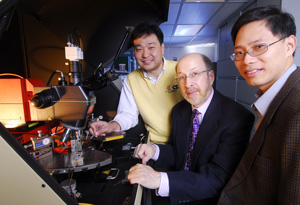
| Home | About Us | Contribute | Bookstore | Advertising | Subscribe for Free NOW! |
| News Archive | Features | Events | Recruitment | Directory |
| FREE subscription |
| Subscribe for free to receive each issue of Semiconductor Today magazine and weekly news brief. |
News
26 June 2008
Seeking deep UV avalanche
Gallium nitride based avalanche p-i-n photodiodes (APDs) sensitive to ultraviolet radiation are being developed at Georgia Institute of Technology with the aim of detecting bioterrorism materials such as anthrax. The latest stage is the production of such APDs using aluminum gallium nitride (AlGaN) layers on free-standing GaN substrates, rather than pure GaN layers on GaN or silicon carbide, as in some of Georgia Tech’s previous work. The latest devices were reported at the 50th Electronic Materials Conference this week in Santa Barbara, CA, USA.
It is hoped that such UV detectors could replace bulky, fragile, power-hungry photomultiplier tubes or silicon photodiodes with complex filtering to block out visible light in applications such as compact, reliable and cost-effective sensors for detecting anthrax and other airborne bioterrorism agents. Other possibilities include the detection of fires, gun muzzle flashes, missile propulsion flames and even cancer cells.
Funding comes from the US Defense Advanced Research Projects Agency (DARPA) and the Georgia Research Alliance. The leading collaborators are associate professor Douglas Yoder, assistant professor Shyh-Chiang Shen and senior research engineer Jae-Hyun Ryou.
The team chose to develop avalanche photodiodes for anti-bioterrorism applications because such devices can detect signature fluorescence from biological molecules in a sample of air. Since most of the molecules of interest to the researchers emit ultraviolet light, they aim to produce photodiodes which detect fluorescence in the ultraviolet region (<380nm) but which have no response to visible light (750-380nm).
The goal is reliable, robust photodiodes with high gain (many electrons per photon through avalanche carrier multiplication). The researchers have fabricated high-performance GaN-based ultraviolet avalanche photodiodes on bulk GaN substrates that demonstrate optical gains of 100,000 at ultraviolet wavelengths of 280-360nm. Georgia Tech claims this is the first time that GaN has been used successfully in the fabrication of photodiodes having ultraviolet optical gains greater than 10,000.
Also under development are ‘Geiger-mode’ photodiodes capable of detecting single UV photons. Yoder is developing computer models of the photodiodes to calculate detailed electronic and optical transport properties, with one goal being to optimize the materials and design of Geiger-mode avalanche detectors for optimal, reproducible performance.
Professor Russell Dupuis of Georgia Tech’s School of Electrical and Computer Engineering (ECE) comments: “Doug’s work is pivotal because these applications don’t require one working detector; they might require thousands of uniform detectors in the same chip that all function the same way, so our ability to manufacture identical photodiodes and detectors is important.”

Picture: Researchers in Georgia Tech's
The ultra-wide band gap compound AlxGa1-xN devices reported at EMC have been grown on free-standing aluminum nitride and GaN substrates. A large Al fraction (x>0.3) is essential for producing sensors that are blind to solar radiation. Although some sunlight is UV, the overwhelming majority (~98%) is UVA (400-315nm, the range put out by UVA lamps, trespassing into the violet region).
The bandgap range from GaN (x=0) to AlN (x=1) is 3.4-6.2eV or, in terms of wavelength, 365nm-200nm. While the bandgap is in the ultraviolet, some visible light out to the blue wavelength of ~440nm is detected in pure GaN APDs through electric-field-assisted tunneling absorption. So, introducing aluminum is designed to push up the bandgap energy and eliminate this unwanted detection. However, the lattice constant of the wider-bandgap material is different from that of pure GaN, introducing mismatched layers. This mismatch leads to the most important problem of nitride devices in general – defects such as dislocations and strain-induced cracking. Another important problem is the limitation in the ability to dope the material.
In addition to growing the devices on low-dislocation-density substrates, the researchers have employed various metal-organic chemical vapor deposition (MOCVD) growth parameters and processes including modulated-precursor epitaxial growth, along with adopting several strain-management structures between the substrate and AlGaN layers to prevent the initiation and propagation of cracks.
At this stage, the experimenters have developed Al0.05Ga0.95N APDs on GaN (silicon-doped n-type layer; 0.25micron unintentionally doped or intrinsic drift region; Mg-doped p-type, heavily Mg-doped contact). The device was tested using a UV-lamp monochromator system with a peak wavelength around 250nm. Peak absorption was observed at 350nm, the equivalent wavelength to the bandgap of the AlGaN material used. Stable true avalanche gain was achieved with a maximum value of about 50 at a voltage of 86.75V.
Attempting to push the Al-content beyond 0.05, the group has used interlayers and/or multiple short-period Al/GaN superlattice structures to avoid cracking. AlGaN device layers on free-standing AlN substrates are also in development, although Georgia Tech is not ready as yet to report results.
Dupuis comments on the AlN substrate work: “Our goal is the demonstration of AlGaN PIN APDs with low reverse-bias leakage currents with x~0.3-0.4 as the absorbing layer grown on AlN substrates. We need a window layer of AlGaN with x around 0.5-0.7 and a transparent AlN substrate for back-side illumination, which is not yet available.”
Search: Avalanche photodiodes AlGaN GaN substrates
Visit: www.ece.gatech.edu
The author Mike Cooke is a freelance technology journalist who has worked in the semiconductor and advanced technology sectors since 1997.